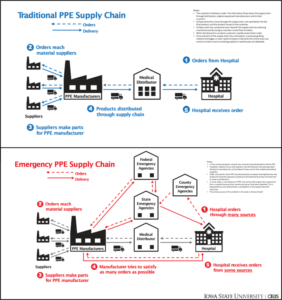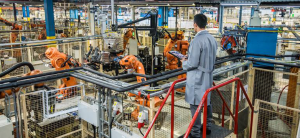By Mark Schmit, Partnerships Manager, NIST Manufacturing Extension Partnership (MEP)
Polaris MEP is the Rhode Island Center for the MEP National NetworkTM, which is here to help U.S. manufacturers through these unprecedented times. Our mission is to strengthen and empower U.S. manufacturers.
The COVID-19 pandemic has made us more aware of the items we purchase on a regular basis and how they get to store shelves and to our doors. Anyone else still waiting two to three weeks longer for orders of sanitizing wipes and paper towels? Now, if we as consumers have experienced these longer wait times and find ourselves (still) refreshing the delivery notifications on our latest online purchases, imagine what’s going on behind the scenes!
 Manufacturing leaders have told us this pandemic has really made them think about risk. Nearly all of the manufacturers we have spoken to mentioned that their immediate focus was on the risk to the health of their workers and their businesses. But beyond that, the spread of the novel coronavirus and the unprecedented Great Lockdown of the U.S. and world economies have shined a bright light on the weak links in their operations.
Manufacturing leaders have told us this pandemic has really made them think about risk. Nearly all of the manufacturers we have spoken to mentioned that their immediate focus was on the risk to the health of their workers and their businesses. But beyond that, the spread of the novel coronavirus and the unprecedented Great Lockdown of the U.S. and world economies have shined a bright light on the weak links in their operations.
In 2020, the National Institute of Standards and Technology’s Manufacturing Extension Partnership (NIST MEP) organized a series of listening sessions — the “National Conversation with Manufacturers” series. We heard from 50 manufacturing leaders from across the country about how they are handling the near-term jolt from the pandemic and are preparing for success in the long-term.
They see risk in their supply chains, their workforces, their standard practices and in pulling back from innovation. Mitigating those risks, manufacturers across the nation say, comes in the form of local partnerships, long-term agreements, internalizing some outsourced supply, and automation.
Mitigating Risk
Most Rhode Island manufacturers can relate to the discussions of risk during the Sept. 9, 2020 panel representing Southeastern states.

Their experiences in the early weeks of the COVID-19 pandemic and in the months since have exposed weak links in supply chains and have revealed the benefit of physically close relationships with suppliers, as well as customers. Disruptions have exposed the potential risks to their operations that have come from pursuing low-cost components without considering the full price to be paid in the event of disruption or defect.
Concerns over supply interruptions have led to some internalizing of externally sourced components where such activities align with their own processes and vertical integration strategies. Companies that rely on local suppliers, whether by choice or due to federal requirements of defense contractors, have not reported the same level of disruption as those sourcing components from outside the country.
The manufacturing executives espoused the value of nurturing relationships and entering into long-term agreements with customers as well as suppliers. Long-term contracts, they say, help both companies by providing stable levels of production, sales and finished goods. They also have noted the challenge of maintaining lean principles in the face of supply chain disruptions. One manufacturer described how his company had sought to double its usual inventory of raw materials and finished goods to ensure an adequate supply.
Polaris MEP’s Chris Cinieri says many Rhode Island manufacturers have had similar experiences. Chris is the Rhode Island point person for the MEP National Network’s “Supplier Scouting” program. He works with local companies to help them find backup or secondary suppliers, reducing risk.
Innovation Is Key
Yet, times of crisis also tend to make risk-averse manufacturers pull back from innovation at the very time it is most needed, one participant noted. Calling innovation the key to emerging stronger on the other side of this pandemic, he said that his company was continuing to make planned investments in automation.
 Investments in technology, they say, address three important needs: innovation necessary for continued growth, productivity gains and a response to ongoing workforce challenges.
Investments in technology, they say, address three important needs: innovation necessary for continued growth, productivity gains and a response to ongoing workforce challenges.
Despite high unemployment in the wake of the pandemic, only one of the manufacturing executives reported no problems in attracting the talent — largely workers with advanced degrees — his company needed. The other conversation participants view workforce as another potential risk to their growth. The need is twofold: 1) skilled trades and vocational workers to serve in such roles as machinists, tool and die makers and industrial mechanics and 2) engineers and engineering technicians who can design tools and processes as well as troubleshoot problems.
Acknowledging the risks the pandemic has exposed and working to address them now will yield dividends in the future for American manufacturing.
Please contact the team at Polaris MEP to learn about resources available to help you address risk and support innovation.
